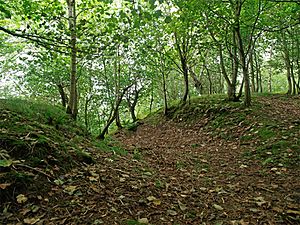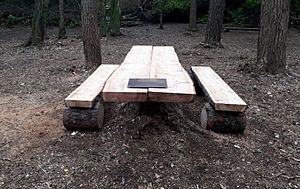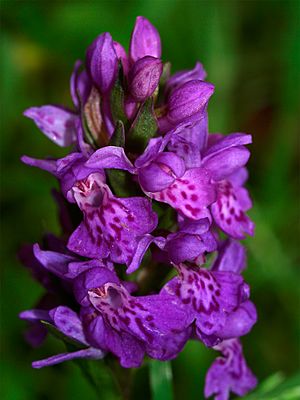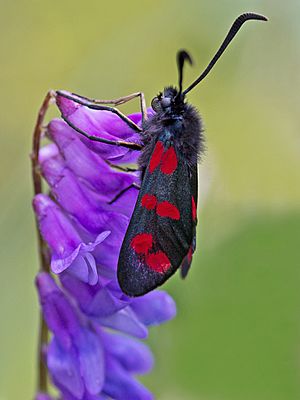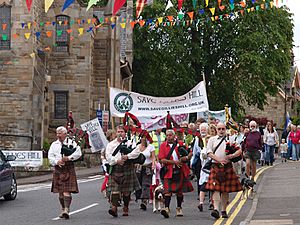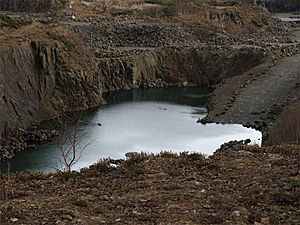Gillies Hill facts for kids
Quick facts for kids Gillies Hill |
|
|---|---|

The view of Gillies Hill, Scotland, taken from beneath Stirling Castle
|
|
| Highest point | |
| Elevation | 162 m (531 ft) |
| Prominence | 85 m (279 ft) |
| Geography | |
| Location | Scotland |
| OS grid | NS771911 |
Gillies Hill is a special place in Central Scotland. It's located west of Stirling and the M9, near the town of Cambusbarron. This hill is about 162 metres (531 ft) (531 feet) high.
Gillies Hill is famous for its connection to the Battle of Bannockburn in 1314. Legend says that Robert the Bruce's camp followers, called "Gillies," helped win the battle. The hill is also home to a large area of very old woodland. This woodland has been here for centuries, with some trees dating back to the 1580s.
Contents
Discovering Gillies Hill's Past
People have lived on and used Gillies Hill for thousands of years. It has a rich history, from ancient times to today.
Ancient Times
The very first buildings on Gillies Hill were made by Iron Age people over 2000 years ago. They built two main structures: Wallstale Dun and Gillies Hill fort. These forts were built on high points, allowing people to see for miles around. This helped them spot anyone approaching.
In 1984, archaeologists explored Gillies Hill fort. They found three stone walls that were part of its defenses. Inside the fort, they discovered pieces of pottery and other items. These findings suggest that people lived there during the Iron Age. There might have been activity even earlier, during the Late Neolithic/Early Bronze Age.
The Battle of Bannockburn, 1314
The name "Gillies Hill" might come from a famous story about the Battle of Bannockburn. In 1314, Robert the Bruce led the Scottish army against the English. His camp followers, or "sma' folk," were told to wait safely in the woods.
According to an old Scottish poet named John Barbour, these followers came down the hill during a key moment in the battle. They made a lot of noise, banging pots and waving clothes. The English army thought these "newcomers" were more Scottish soldiers and fled in panic. This helped the Scots win the battle, giving Scotland almost 400 years of independence. While the story is famous, some historians think this event might have happened on a different nearby hill.
Bruce’s Well
Before the Battle of Bannockburn, Robert the Bruce is said to have visited Cambusbarron Chapel. He drank from the Chapel Well, now known as Bruce's Well. Water from this well was even sprinkled on the battlefield before the fight. A special stone block was placed there in 2014 to remember its role in the battle.
The Bonnety Tree
On the northwest side of Gillies Hill, there were many old Scots pines. One of these was called the Bonnety Tree. Legend says that the Gillies hung their bonnets on this tree before they rushed down to the battlefield. Sadly, this original tree is gone due to quarrying. However, a new "Bonnety Tree" was planted in 2016 to keep the story alive.
Polmaise Castle and Murrays Hall
In the middle of Gillies Hill are the ruins of Polmaise Castle. It was built in 1865 for a wealthy man named Col. John Murray. He hired an architect to design this grand Scottish Baronial mansion. Sadly, the castle was torn down in 1966.
Before Polmaise Castle, the Murray family lived in Touchadam Castle, which is now also in ruins. Later, Murrays Hall was built nearby in 1673. It was home to three kind Jacobite Ladies. They were known for their hospitality and secretly supported the Jacobite cause. They would toast "To Him over the water" or subtly move their glass over a water pitcher to show their loyalty. Murrays Hall later became a farmhouse but was destroyed by quarrying in the 20th century.
Free Green
The Old Drove Road on Gillies Hill leads to a place once called Cambusbarron's Free Green. In the past, villagers and travelers would gather here to tie up their animals. It was also used for special celebration bonfires until 1953.
Amazing Views from Gillies Hill
Gillies Hill offers incredible views in every direction. It's considered an "Area of Great Landscape Value" because of its beautiful scenery. When you look from Stirling Castle, Gillies Hill is the first hill you see to the west. It stands opposite other famous landmarks like Castle Craig and Abbey Craig.
From the Hill Fort on Gillies Hill, you can see the Touch Hills, the Carse of Stirling, and even parts of the Southern Highlands like Ben Ledi. Looking east, you'll spot Stirling Castle, Abbey Craig, and the Wallace Monument. To the south, you can see the Bannockburn Heritage Centre with its statue of Robert the Bruce.
Fun Things to Do on Gillies Hill
Gillies Hill is a popular spot for outdoor activities. People have been walking, jogging, and exploring its paths for many years.
- Walking and Hiking: There are paths for all levels, from easy strolls to more challenging hikes. Some popular routes include the Quarry Walk, the Lake Walk, and the Tree Tour. Be careful in winter, as paths can get muddy and slippery.
- Geocaching: If you enjoy treasure hunting, you'll find over 40 geocaches hidden on and around the hill!
- Rock Climbing: For experienced climbers, the steep rock faces offer exciting routes.
- Mountain Biking: Downhill bicycle racers and stunt cyclists have created challenging circuits and jump parks.
You can find maps and information about Gillies Hill at the car park at the end of Old Drove Road in Cambusbarron. The Cambusbarron Community Council provides brochures on the hill's plants and animals, history, and recreational activities.
Gillies Hill Community Woodland
After many years of hard work, a large part of Gillies Hill (64 hectares) became community-owned in 2019. This means the local community now helps manage it. The goal is to make it even better for walking, mountain biking, horse riding, and enjoying nature.
A Community Forest Manager helps look after the woodland. Volunteers also work hard to restore the old Polmaise Castle gardens, install benches, and create picnic areas. They even give guided walks to share the hill's beauty.
Gillies Hill's Environment
Weather and Water
The weather on Gillies Hill is mostly affected by winds from the Atlantic Ocean. Winters are often wet and windy. The area gets about 1060 mm (41.73 inches) of rain each year.
The Bannock Burn river borders the hill to the south. It flows into the River Forth, which then goes out to the North Sea. Several smaller streams also flow from the hill into the River Forth.
How the Hill Was Formed
Gillies Hill is a "crag and tail" formation. This means it has a steep, rocky side (the "crag") and a gentler, sloping side (the "tail"). These formations were created by glaciers moving across the land about 10,000 years ago. The glaciers shaped the harder rock into cliffs and left softer material trailing behind.
The hill is made of a strong rock called quartz-dolerite. This rock is very tough and has been used for roads and buildings. There were also limestone mines under the hill. Limestone was used to make building materials and for farming. You can still see the remains of old lime kilns around the hill.
Plants and Animals of Gillies Hill
Gillies Hill is home to many different types of plants and animals. It has a mix of habitats, from pine forests to ancient woodlands.
Plant Life (Flora)
The hill has a huge variety of native Scottish plants. It's especially known for its "Ancient Woodland indicator species." These plants show that the woodland has been there for hundreds of years. You can find many popular Scottish plants here, like heather, Scottish bluebells, Scots Pine, and thistles.
Ancient Woodland
Much of Gillies Hill is classified as a Semi-natural Ancient Woodland. This means that the plants growing on the forest floor have been there for centuries. Plants like wood sorrel and English bluebells likely grew here even during Robert the Bruce's time!
Special Trees
Gillies Hill has some truly impressive trees. One Scots Pine, nicknamed "The Big Pine," is one of the largest of its kind in Britain. There are also many other "Veteran Trees" – very old and important trees – listed with the Woodland Trust. Along the western cliffs, you can find ancient Scots Pines that are part of a significant pinewood area.
Invasive Plants
Some plants on Gillies Hill are not native and can harm the local ecosystem. For example, Acaena ovalifolia (pirri-pirri burr) spreads quickly and outcompetes native wildflowers. Rhododendron ponticum, planted in the 1800s, has also spread widely. It blocks sunlight from reaching the forest floor, making it hard for other plants to grow.
Plants and History
The plants on Gillies Hill tell part of its history. The Murray family, who built Polmaise Castle, created beautiful gardens with exotic trees. They planted tall conifers from North America, like the giant Sierra Redwoods (or Wellingtonia) you can still see today. These trees could live for thousands of years!
Around the castle's "Secret Spring," you'll find native woodland plants like wood anemones and bluebells. There are also other impressive foreign trees planted by the Murrays, including Coast Redwoods and a Monkey-puzzle tree.
Native trees like silver birch, oak, and Scots Pine are vital for the hill's ecosystem. Their cones provide food for animals like Red Squirrels. Some plants on the hill were introduced by humans long ago and have become naturalized, like the Flanders Poppy.
Wildflowers
Over 200 types of flowering plants have been found on Gillies Hill. In early spring, snowdrops appear. In May, the forest floor is covered with English bluebells. Later in the summer, you'll see Scottish bluebells, also known as harebells, which are a lighter blue.
Mosses and Fungi
Besides the big trees and flowers, Gillies Hill is home to many smaller organisms. There are 48 species of mosses and 22 species of liverworts. You can also find seven types of ferns, along with many fungi, lichens, and algae.
Animal Life (Fauna)
Gillies Hill is full of animals, both those that live there all the time and those that visit.
Mammals
You might spot red and roe deer, red foxes, and badgers. The native red squirrel also lives here, especially in the pine woodlands. Red squirrels are facing challenges from grey squirrels, who compete for food and carry a harmful virus. However, pine martens, which eat grey squirrels, have recently appeared on the hill, which might help the red squirrel population.
Badgers are shy, nocturnal animals, but you can find signs of them on Gillies Hill, like their paths and footprints. Bats have also been detected flying around the hill.
Birds
Many small birds, like robins and finches, live in the woodlands. Larger birds like crows and ravens are also common. You might even see birds of prey, such as peregrine falcons on the cliffs. Red kites, which are rare, have also been spotted flying over the hill.
Amphibians
Palmate newts live in a small loch (lake) called Loch Kruse at the top of Gillies Hill. Common toads can also be found near Polmaise Castle.
Insects and Other Invertebrates
Gillies Hill is home to a huge number of invertebrates (animals without backbones). So far, 88 species have been found, including bumblebees, wasps, dragonflies, butterflies, and many types of beetles.
Protecting Gillies Hill
Gillies Hill has faced threats from quarrying in the past. Quarrying means digging out rock from the ground. A group called "Save Gillies Hill" was formed to protect the area. They organize an annual "March of the Gillies" to raise awareness.
The Cambusbarron Community Council also works to preserve the hill. They want to create a community woodland, safe trails for biking and hiking, and protect the hill's historical sites like the Iron Age fort and Polmaise Castle.
There is currently a concrete plant operating in Murrayshall Quarry. Quarrying has happened on Gillies Hill in the past, with operations stopping in 1996. However, permission was granted for quarrying to continue until 2042. Local groups have been working hard to ensure that any future quarrying is carefully reviewed and that the environment is protected.
In 2020, a plan for a new access road to the quarry was refused due to concerns about noise, air quality, road safety, and the loss of ancient woodland. However, in March 2021, a decision was made to allow a new access track, meaning quarrying could restart. The community continues to work to protect this important historical and natural site.





